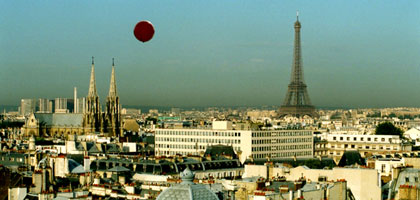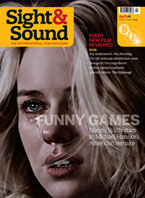Flight of the Red Balloon
France/Taiwan 2006

Reviewed by Kate Stables
Synopsis
Our synopses give away the plot in full, including surprise twists.
Paris, the present. Seven-year-old Simon is followed around the city by a mysterious red balloon.
His mother Suzanne, busy rehearsing a new play for her Chinese puppet theatre, hires Taiwanese film student Song as Simon's childminder. For her college project - a homage to Albert Lamorisse's famous 1956 film The Red Balloon - Song starts to film Simon walking and playing around Paris. She develops a rapport with mother and son, and translates for Suzanne's masterclass with a Chinese puppet master. Simon misses his teenage half-sister Louise, who visits Paris occasionally and teaches him pinball. The balloon appears periodically outside Simon's cramped apartment, either drifting over the neighbourhood rooftops or bobbing outside his window. Suzanne works on her new puppet play, and tries to evict her downstairs tenant Marc, who has failed to pay his rent. She argues on the phone with Pierre, Simon's father, who has absented himself to Canada for two years to write a novel and who is rarely in touch. The balloon appears again outside Simon's apartment, unseen by Song or Simon. Suzanne evicts Marc, who yells that Pierre will never come back to her. Simon visits the Musée d'Orsay on a school trip, where his class is shown The Ball, a painting by Félix Vallotton in which a child chases a red ball. As they discuss it, the red balloon bumps against the museum's skylight windows before flying off over the city.
Review
Finding a serene and contemplative beauty in the quotidian world has long been Taiwanese master-minimalist Hou Hsiao Hsien's stock in trade. This delicate, deceptively low-key tale of a Parisian single mother's attempts to pull herself out of emotional chaos is his first European movie, but it develops several of the motifs of 2003's Ozu-inflected Café Lumière. Once again, a woman seeks answers, while the camera roams purposefully, drinking in a strange city in a manner simultaneously agile and yet gloriously dawdling, all the while paying homage to a famous cinematic predecessor.
Here the film Hou is drawing on is Albert Lamorisse's 1956 childhood classic The Red Balloon, which informs The Flight of the Red Balloon in ways far more subtle than its copycat title might suggest. Typically, the movie is sustained by a narrative string as slender as that suspended from the mysterious red balloon which periodically follows placid seven-year-old Simon as he treks around Paris with his film-student childminder Song, while his mother Suzanne (Juliette Binoche) ricochets nervily between rehearsing her new Chinese puppet show and trying to maintain her family life. Hou, as deft as a Dutch master at depicting domestic interiors, lets the film record the trio's daily life in long, meticulous takes that delight in small gestures - the pouring of juice, the eating of pastry, Suzanne biffing her head on the cramped apartment's lamp. Like a Vermeer, however, the household's emotional crises leak into the picture through telling details: Simon muses on his much-missed teenage half-sister Louise; and when Suzanne rages over her inability to find the lease document that can evict her feckless downstairs tenant, we're immediately aware of her fragility and fury at being marooned in Paris while Simon's father writes a novel in Canada.
Hou brings the same depth and deliberation to the film's Parisian exteriors, where Song and her ever-present camera become the director's stand-in, her outsider eye filming Simon as he plays pinball in cafés or rides the carousel in the Luxembourg Gardens, in images that will become (in a sly postmodern twist) a student film project paying overt homage to The Red Balloon. In one scene, the film and film-within-the-film even touch base, as Song shows Simon how the green-clad extra carrying her film's 'magic' red balloon will be erased in post-production. The film makes gentle play too with the irony of Song faking a red balloon for Simon while a real one bobs periodically outside his window. Unlike Lamorisse's cheerfully whimsical version, here the balloon serves a symbolic rather than a narrative purpose - it may follow Simon as faithfully as the camera does, but it never becomes his little helium-filled friend.
Entering these episodes of sun-dappled, after-school quiet, the blowsy blonde Binoche jolts her scenes awake with nervous energy, whether dashing through the household she is holding together by force of will, or voicing her Chinese puppet show with swooping vocal talent. The film's sketchy, improvised dialogue springs to life in her hands, which it doesn't always for the rest of the cast. Her frazzled, human performance is the film's keystone - just watch her light up a mundane mother-and-child exchange about school maths, her mobile face turning it into a tender, preoccupied affirmation of affection for her son.
Despite its small-scale narrative and intimate style, The Flight of the Red Balloon benefits from skilful thematic underpinnings, as Hou subtly contrasts Suzanne's personal struggles with the puppet story she is recreating, that of stoic sea-emptying philosopher Zhang Yu. Unsurprisingly, also running throughout is Hou's perennial preoccupation with how the past and its art resonate through characters' lives. Even Simon, discussing an 1899 Félix Vallotton painting of a child chasing a red ball, striped by light and shade, which he describes as "both happy and sad", isn't immune to its power. But ultimately, it is cinema that is the film's sacred repository of memory and creativity, as Song recreates and remodels Lamorisse's iconic Paris to discover her own.
Credits
- A film by
- Hou Hsiao Hsien
- Produced by
- François Margolin
- Kristina Larsen
- Screenplay
- Hou Hsiao Hsien
- François Margolin
- Freely adapted from Albert Lamorisse's film Le Ballon rouge (1956)
- Director of Photography
- Mark Lee Ping Bing
- Editor
- Liao Ching Sung
- Art Directors
- Paul Fayard
- Hwarng Wern Ying
- Original Music
- Camille


